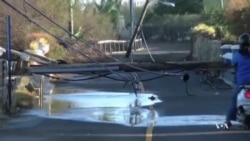Severe storms that cause heavy damage throughout the world are a reminder of how important it is to be able to predict the weather. A meteorological exhibition in Brussels earlier this month featured the latest technology to help improve our ability to forecast the weather and better prepare for its effects.
On October 17, Hurricane Gonzalo hit the island of Bermuda, knocking down trees and power lines, and making roads and streets impassable. The damage was substantial. But thanks to early warnings from forecasters, residents were able to prepare and no deaths or serious injuries were reported.
Scientists say weather systems are notoriously hard to predict because so many variables have to be taken into account. But increasingly sophisticated algorithms and accessibility to supercomputers are making weather prediction much easier.
The U.S. National Oceanic and Atmospheric Administration (NOAA) says its new storm prediction system, called NEIS, collects millions of data points from all over the world to create a four-dimensional model of the world’s weather.
Agency director Alexander MacDonald said the storms created by the computer model are very similar to real ones that have been observed in recent years.
“So this really shows the skill that we are developing, when we run a computer model and Mother Nature does the same thing with the real world and they are pretty alike. We are excited a lot about these improvements,” said MacDonald.
Air pollution is another modern calamity that affects large cities and industrial areas. So its adverse effect on health also makes its timely measurement important.
Alan Taylor, Director of the Britain-based company Turnkey Instruments, said their device, called Topas, uses lasers to monitor the air for particulates.
But, he said, providing accurate measurement does not solve the problem.
“It's what cities do about it when they know about it. Do they stop traffic going through, do they stop trucks going through? So we can get that information, but what the city does with that information is a different situation,” said Taylor.
Even in cities that do not have pollution problems, it is important to measure other atmospheric conditions, like the level of pollen, which can make life miserable for those who are allergic to it.
University of Geneva research team leader Svetlana Afonina said their new instrument, called Plair, uses an optical detector with ultraviolet laser technology.
“The device is highly specific and allows identification of different kind of particles in the atmosphere. We are able to measure and detect different species of pollen in the real time,” said Afonina.
The Brussels exhibition, now in its fifth year, drew more than 2,500 people from around the world to see the latest weather and climate change forecasting technology.






